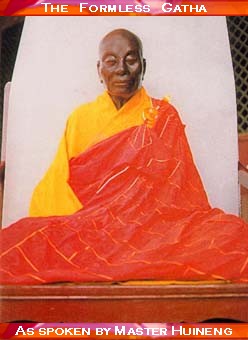
Introduction
by Master Yung Hsi, and edited by Dr Chou Hsiang-Kuang
The Fa Bao Tan Jing(1) was delivered by Huineng [638-713], the Sixth Patriarch of the School of Chan (Dhyana) Buddhism of China. It discusses the realisation of the Essence of Mind. It is not based on superstition, nor does it fall into the same line of thought as the teaching sects of Buddhism. It is indeed a wonderful book in the ocean of Buddhism. It has been translated into English, German, and other foreign languages. It can be said that [through it] Buddhism has been propagated in the western countries.
The Fa Bao Tan Jing is divided into ten chapters. Of these the chapter on Prajñya (Wisdom) is important, and in the Prajñya Chapter the Formless Gātha is most important.
In studying this book we must read every sentence carefully. Only after doing so shall we be able to understand the aims and objectives of Chan Buddhism. After that, when we speak of Chan Buddhism, it will not be mere empty talk, and others will not cheat us on this very subject, nor will we cheat ourselves.
The Formless Gātha contains sixty sentences of five words each. The meaning of these sentences seems very easy. If educated people read them carefully, there will be no need for comments and explanations. In fact there is a supreme meaning inside the gāthas(2) that explains the whole idea of the Fa Bao Tan Jing and the secret Dharmagate of the Tung Shan School(3) that Huineng preached.
Notes:
(1) [The Platform Sutra.]
(2) [A gātha is a song or a verse.]
(3) The Tung Shan School is the School of the 4th and 5th Patriarchs who lived in Tung Shan (Eastern Hill).
This commentary is published on the Net because it is such an utterly Chinese expression of Buddhism, and could therefore serve as a comparison with other such texts.
The original wording in the following pages follows the old Wade-Giles spelling method. The footnotes between [...] are additions by the webmaster.
Since the translator had some difficulty in faithfully rendering the two extensive passages from the Lotus Sutra in the discussion of Gatha 3, it has been decided to give the translation by the late prof H. Kern, which seems to be the most comprehensive version.
The Three Traditions are the Traditions of Confucianism, Taoism and Buddhism. Right after the introduction of Buddhism in China the exegetes had to rely on the Confucianist and Taoist discourse in order to get the Buddha-Dharma accross; this indigenisation even went as far as hoisting Buddhism on the wagons of Confucianism and Taoism. There are innumerable accounts of this, and these accounts, dating from the early ages of Buddhism in China, have led to the assumption that 20th (and 21rst) century Chinese Buddhism still is heavily influence by the other two Tradition.
Especially since a complete translation of the Avatámsaka Sūtra became available this assumption has to be corrected. What initially appeared as Taoist discourse in Buddhist exegesis can now be attributed to the said Sūtra. We may now come to the conclusion that the main tenets of the two other Traditions are used to illustrate the Buddha-Dharma, rather than being used as an illustration of how much Buddhism 'really' is a form of Taoism and/or Confucianism. This, however, excludes Master Yung Hsi's words on the true gentleman, the chün-tze or jūnzi; this Confucianist concept truly has become a trait of Chinese Buddhism, and lies behind the worldview of the ancient Japanese samurai - to give an example.
The venerable also extensively made Hsi Yün's (a.k.a. Huangbo) words his own. Huangbo was the third or fourth successor of master Huineng. (pronounciation of Huangbo [choose the mandarin version])
As of gātha 5 the commentary speaks several times of Tao. In the Taoist sense of the word it means "the way things take, the course of things." In general philosophical terms it stands for any set religious or philosophical doctrine. In Buddhism it is an imperfect translation of the Sanskrit word marga, Path. And as the Path is at the same time both the means and the end, tao also means 'method'; see also gātha 9 for an explanation on the word bodhi, tao or chiao. Tao also means piety.
It is customary, especially among the Zen Schools that sprung up in the West, to keep a certain doctrinal purity. The inheritors of the Japanese Rinzai Tradition (Chin. Lin-chi o Linzi) will teach the famed Rinzai Master's Dharma, The Sōtō Tradition does likewise. There is little or no 'cross fertilization', both in order to keep the teaching lineage pure, and to prevent the student-meditator from feeling insecure about particular views.
Chinese Buddhism as a whole, and Chinese Chan in particular, never bothered much about this type of purity. Its aim is more to stress the common traits in this and that Dharma exegesis. We therefore see how Master Yung Hsi used the teaching of a southern Ho-tse Chan Master like Tsungmi to demonstrate the correctness of the northern Tungshan lineage Mandarin pronounciation of Tungshan).
Such cross cultural behaviour occurs very often and is perhaps characteristic for Chinese Buddhism.
In case some citations not previously posted on The Web or published in books are not rendered as they should be, it would be very good if you would be so kind as to send in corrections. See the email address below.
November 2006
|
